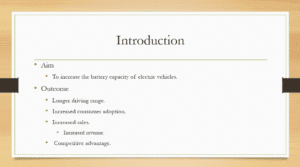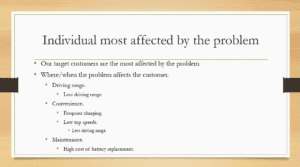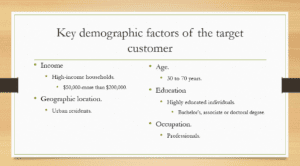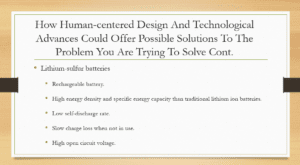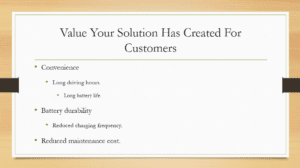Improving EV Batteries to Increase EV Sales
Hello. Welcome to my presentation on improving EV batteries to increase EV sales
The aim of the project is to increase the battery capacity of electric vehicles. One of the project outcomes is a longer driving range. The new batteries will have a high power capacity, thus supplying power for long to sustain long drives. The second outcome is increased customer adoption. The new batteries will be more efficient due to the large power capacity, which will lead to high customer adoption. The third outcome is increased sales, which will result from high customer adoption. Increased sales will enable the company to generate more revenue. The fourth outcome is a competitive advantage. The large battery capacity is a unique feature that will attract more customers leading to a competitive advantage. Do you need help with your assignment ? Hire our assignment writing services in case your assignment is devastating you.
The problem I am trying to solve is the low battery capacity for electric vehicles. One of the issues resulting from the problem is battery lifespan concerns. The battery may not last long if it is frequently charged. Drivers who use their electric vehicles often over long distances have to charge their batteries to cover long-range drives frequently. Customers may also stop using electric vehicles because replacing EV batteries is expensive. Another issue is low top speeds. Vehicle top speeds are the fastest speeds a car can move. Although electric cars can move fast, most drivers prefer maintaining a low speed to conserve power due to the limited drive range.
Our customers are the most affected by the problem. One of the areas where the problem affects the customer is driving range. Low battery capacity reduces driving range, thus limiting the distance that the customers can drive their electric vehicles before recharging. The second area is convenience. Customers may be inconvenienced when they have to frequently charge their electric vehicle batteries when traveling over long distances. Inconvenience also arises from low top speeds as drivers try to conserve energy so that they can drive for long distances with limited power in the batteries. The problem also affects customers when they have to replace the battery. The cost of replacing electric batteries is high, thus increasing maintenance costs. According to Vandiver (2022), replacing electric vehicle batteries costs between $4,000 and $20,000.Therefore, customers may opt for non-electric vehicles instead of replacing a battery.
Demographic factors are the characteristics used to describe a group or person (Wilson, 2016). Our target customer’s demographic factors are classified into income, geographical location, age, education and occupation. The target customer includes individuals from high-income households with an income between $50,000 to more than $200,000.The geographical location of the target customer is urban residents. The target customer also includes individuals aged between 30 to 70 years. Electric vehicles also target highly educated individuals with bachelor’s, associate, or doctoral degrees. The occupation of the target customer is professionals.
Human-centered design and technological advances could offer possible solutions to the problem I am trying to resolve through solid-state batteries. According to Bupesh Raja et al. (2021), solid-state batteries are made up of solid components that support ion transport and electron transfer. The second feature of solid-state batteries is high energy. The batteries have higher energy than Li-ion batteries. The third feature is that they are safer than the other batteries that use the current system. Solid-state batteries are also non-flammable, thus enhancing their safety. The fifth feature is that they do not have electrolyte leaks. They also increase energy density by using fewer batteries.
I can use lithium-sulfur batteries to increase battery capacity. One of the features of lithium-sulfur batteries is that they are rechargeable. The second feature is that they have higher energy density and specific energy capacity than traditional lithium-ion batteries. The third feature is that they have a low self-discharge rate. Therefore, they can be used for a longer time compared to other batteries. The fourth feature is that they have slow charge loss when not in use, and therefore, they preserve energy for a long time. The fifth feature is that they have high open circuit voltage, thus charging faster.
I can also use supercapacitors to increase battery capacity. Supercapacitors are an innovation aimed at storing chemical energy while following a principle different from that of a battery. Supercapacitors store energy in an electrostatic field. They can handle high current rates, thus making them eligible for fast charging options. Another feature of supercapacitors is that they have low energy density to volume and weight. The price per unit of energy when using supercapacitors is also high.
One of the initial constraints that may limit or hamper the introduction of the new technology is the shortage of raw materials. For example, a shortage of battery components and labor could delay the production of the new batteries. The second constraint is delays in the production of batteries at scale because the batteries have to be tested before they are released to customers. The third constraint is competition for resources with other battery manufacturers. High competition could increase the price of supplies, leading to high production costs.
One of the possible variants of the design challenge is power density. The selected system has to cope with high power current densities during recharge and low densities during discharge. The second variant is energy density. According to Fontes (2021), energy density is limited by the chemistry in a battery, which is determined by the battery’s electrode and the electrolyte’s composition. The third variant is durability. Durability will be dictated by the quality of the material used to produce the batteries. The fourth variant is charging time. The power and energy density will dictate the charging time.
The solution will create convenience, battery durability, and reduced customer maintenance costs. Convenience will be achieved through long driving hours due to long battery life. Battery durability will result from reduced charging frequency. Long battery life reduces the need to charge the batteries, thus increasing battery durability constantly. Reduced maintenance costs will arise from battery durability because the batteries will last longer, thus eliminating the need to replace them.
References
Bupesh Raja, V., Raja, I., & Kavvampally, R. (2021). Advancements in battery technologies of electric vehicle. Journal of Physics: Conference Series, 2129(1), 012011. https://doi.org/10.1088/1742-6596/2129/1/012011
Fontes, E. (2021, June 24). Modeling and simulation for meeting the challenges of battery design. IEEE Spectrum. https://spectrum.ieee.org/modeling-and-simulation-for-meeting-the-challenges-of-battery-design
Vandiver, W. (2022). How Much Do Electric Car Batteries Cost? Nerdwallet. https://www.nerdwallet.com/article/loans/auto-loans/electric-battery-cost#:~:text=The%20good%20news%20here%20is,you%20between%20%244%2C000%20and%20%2420%2C000
Wilson, T. (2016). Visualizing the demographic factors that shape the population’s age structure. Demographic Research, 35, 867-890. https://doi.org/10.4054/demres.2016.35.29
ORDER A PLAGIARISM-FREE PAPER HERE
We’ll write everything from scratch
Question
This assignment aims to create a design challenge that highlights various problem-solving techniques. This assignment will build on the concepts in your Topic 2 “Hypothesis Statements – Overview and Template” assignment.
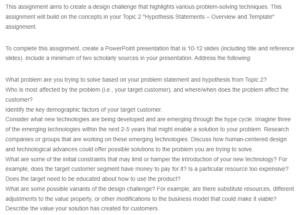
Improving EV Batteries to Increase EV Sales
To complete this assignment, create a PowerPoint presentation that is 10-12 slides (including title and reference slides). Include a minimum of two scholarly sources in your presentation. Address the following:
What problem are you trying to solve based on your problem statement and hypothesis from Topic 2?
Who is most affected by the problem (i.e., your target customer), and where/when does the problem affect the customer?
Identify the key demographic factors of your target customer.
Consider what new technologies are being developed and are emerging through the hype cycle. Imagine three of the emerging technologies within the next 2-5 years that might enable a solution to your problem. Research companies or groups that are working on these emerging technologies. Discuss how human-centered design and technological advances could offer possible solutions to the problem you are trying to solve.
What are some of the initial constraints that may limit or hamper the introduction of your new technology? For example, does the target customer segment have money to pay for it? Is a particular resource too expensive? Does the target need to be educated about how to use the product?
What are some possible variants of the design challenge? For example, are there substitute resources, different adjustments to the value property, or other modifications to the business model that could make it viable?
Describe the value your solution has created for customers.


